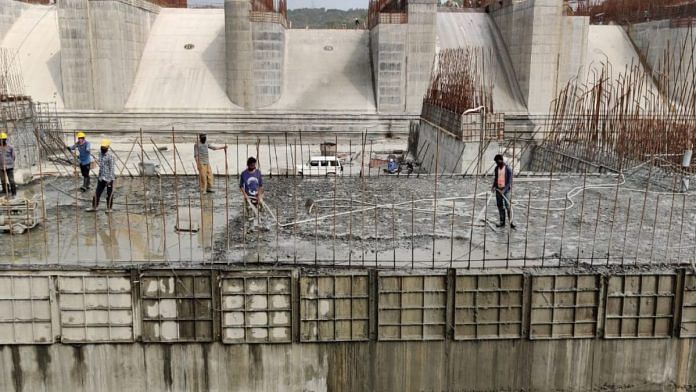New Delhi: Almost three decades after its foundation stone was laid, the Shahpurkandi dam on river Ravi in Punjab, bordering Jammu and Kashmir has finally been completed, senior officials in the Union jal shakti ministry told ThePrint.
The 55.5-metre-high dam is part of the Rs 3,300 crore Shahpurkandi multipurpose river valley project, which also comprises two hydropower plants with an installed capacity of 206 MW. The project, being implemented by Punjab, will help minimise some of the water of Ravi that is currently going waste through the Madhopur barrage downstream to Pakistan.
However, the full benefit of the project — irrigation and power generation — will be realised only after completion of the power plants. The two hydropower plants are expected to be completed by the end of 2025.
A senior official of the jal shakti ministry told ThePrint that initial filling of water has started at the dam and it is currently being tested to ensure safety. “By the end of April or first week of May, the authorities will start impounding water in the dam. This will facilitate irrigation of 5,000 hectares in Punjab and over 32,000 hectares in Jammu and Kashmir,” the official added.
Ravi is one of the three eastern rivers of the Indus river system and its water — under the Indus Water Treaty — falls in India’s share. The treaty, brokered by the World Bank between India and Pakistan in 1960, outlines how the two countries will utilise the six rivers of the shared Indus river system. While water from the western rivers of the Indus system — Indus, Jhelum and Chenab — fall in Pakistan’s share; the three eastern ones — Ravi, Beas and Sutlej — are to be used by India.
Under the treaty, Pakistan gets over 135 million acre-feet (MAF) from the three western rivers, while India gets unrestricted use of over approximately 33 million MAF from the three eastern rivers. India is currently utilising around 94-95 percent of its share of water in the eastern rivers through a network of dams, including the Bhakra on Sutlej, Ranjit Sagar on Ravi, and Pong and Pandoh on Beas.
Shahpurkandi dam, located 11 km downstream of Ranjit Sagar dam on river Ravi and 8 km upstream of Madhopur barrage, will help India better utilise the Ravi waters.
Currently, Ranjit Sagar dam, which can generate 600 MW power, is not generating to its full capacity. “With Shahpur Kandi dam becoming operational, we will be able to operate Ranjit Sagar dam to its full capacity, without spilling water to Pakistan. There will be controlled release of water downstream of Shahpur Kandi, which will allow better utilisation of water at Madhopur barrage,” one of the officials said.
Also Read: Unfinished after 20 yrs, Andhra’s Polavaram dam plagued by technical issues, funds crunch, politics
Slow going
The project has gone through humongous delays. The then Prime Minister P.V. Narasimha Rao had laid its foundation in 1995. But over the years, paucity of funds and dispute between Punjab and Jammu and Kashmir ensured that work continued at a snail’s pace. In 2014, work was stopped again following a dispute between Punjab and J&K.
The central government had to step in and finally in 2018, the Union cabinet declared it a national project. The Centre decided to provide assistance to the tune of Rs 485 crore for the irrigation component of the project, for a five-year period.
Besides the Shahpur Kandi dam project, India’s plans to build a multipurpose project on the Ujh river (a tributary of Ravi) in Jammu and Kashmir for irrigation and hydro power, and the second Sutlej-Beas link project in Punjab. These three projects are key to India’s aim of utilising the water it is guaranteed under the 1960 Indus Waters Treaty with Pakistan.
(Edited by Zinnia Ray Chaudhuri)




Each drop of water allocated to India under the Indus Waters Treaty should be retained and utilised. The next stage, as is happening with the Nile, is for upper riparian states to ask for more, as their populations and needs grow.